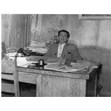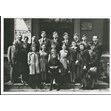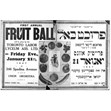- Address
- 216 Beverley Street
- Source
- Landmarks
The Apter Synagogue was formed by a group of people who came to Toronto from the area of Opatow (Apt) in Poland around the turn of the century. They first established a small synagogue on Centre Avenue near Dundas Street in the Ward. In 1918, in anticipation of more Apter immigrants coming to Toronto after the First World War, the synagogue was sold and a larger one purchased on Beverley Street. Both the synagogue members and the Apter Friendly Society met there.
- Address
- 216 Beverley Street
- Time Period
- 1918-unknown
- Scope Note
- The Apter Synagogue was formed by a group of people who came to Toronto from the area of Opatow (Apt) in Poland around the turn of the century. They first established a small synagogue on Centre Avenue near Dundas Street in the Ward. In 1918, in anticipation of more Apter immigrants coming to Toronto after the First World War, the synagogue was sold and a larger one purchased on Beverley Street. Both the synagogue members and the Apter Friendly Society met there.
- History
- In later years, a bitter controversy between the synagogue and society erupted and the building was sold.
- Category
- Political
- Religious
- Private Clubs
- Source
- Landmarks
- Address
- 542 Dundas Street West
- Source
- Landmarks
The Yiddisher Zhurnal (or the Daily Hebrew Journal) was the primary organ for the Yiddish-speaking population in Toronto. This newspaper covered events in the Jewish world in Toronto and abroad. The paper was also a forum for Yiddish essayists. The long-time editor of the newspaper was Abraham Rhinewine (1887-1932). Born in Poland in 1887, he immigrated to London, England in 1902 and then came to Toronto with his wife Amy in 1907.
- Address
- 542 Dundas Street West
- Time Period
- 1910-1975
- Scope Note
- The Yiddisher Zhurnal (or the Daily Hebrew Journal) was the primary organ for the Yiddish-speaking population in Toronto. This newspaper covered events in the Jewish world in Toronto and abroad. The paper was also a forum for Yiddish essayists. The long-time editor of the newspaper was Abraham Rhinewine (1887-1932). Born in Poland in 1887, he immigrated to London, England in 1902 and then came to Toronto with his wife Amy in 1907.
- History
- The newspaper eventually moved to 409 College Street West (at Lippincott). The OJA has the Yiddisher Zhurnal on microfiche from 1915-1959.
- Category
- Political
- Education
- Arts
- Source
- Landmarks
- Address
- 24 Cecil Street
- Source
- Landmarks
The Labour Zionist Order was an outgrowth of the Labour Zionist party in Israel (the Mapai party). They carried out a number of different functions. They were pro-labour and pro-Zionist. They acted as a mutual benefit society—the Labour Zionist Alliance or Farband, formally known as the Jewish National Workers Alliance or Farband Labour Zionist Order. They also operated a school for children called the Farband Folks Shule (later Bialik Hebrew Day School). There was a fundraising organization that they oversaw called the Israel Histadrut of Toronto whose annual campaign raised money for the Israel Histadrut in Israel (the Federation of Labour in Israel), founded in 1920. The campaign money was used to fund economic, trade union, military, social, and cultural activities in Israel, as well as to provide a comprehensive system of health insurance and hospital services to workers. The Israel Histadrut campaign in Toronto had an autonomous executive board, however it's activities were overseen by the Labour Zionist Order.
- Address
- 24 Cecil Street
- Time Period
- 1922-
- Scope Note
- The Labour Zionist Order was an outgrowth of the Labour Zionist party in Israel (the Mapai party). They carried out a number of different functions. They were pro-labour and pro-Zionist. They acted as a mutual benefit society—the Labour Zionist Alliance or Farband, formally known as the Jewish National Workers Alliance or Farband Labour Zionist Order. They also operated a school for children called the Farband Folks Shule (later Bialik Hebrew Day School). There was a fundraising organization that they oversaw called the Israel Histadrut of Toronto whose annual campaign raised money for the Israel Histadrut in Israel (the Federation of Labour in Israel), founded in 1920. The campaign money was used to fund economic, trade union, military, social, and cultural activities in Israel, as well as to provide a comprehensive system of health insurance and hospital services to workers. The Israel Histadrut campaign in Toronto had an autonomous executive board, however it's activities were overseen by the Labour Zionist Order.
- History
- The Labour Zionist Order purchased the house at 24 Cecil Street in 1922 and established a library in it. It was called the Farband Institute.
- Category
- Political
- Organization
- Source
- Landmarks
- Address
- 346 Spadina Avenue
- Source
- Landmarks
Established in 1913 by Henry Dworkin and Sam Easser, the Labor Lyceum Association sought to advance the interests of the city's Jewish trade union movement. Through the sale of $5.00 stock certificates, the community purchased two houses at 344 and 346 Spadina in 1924, adding a new front and meeting rooms in 1929.
- Address
- 346 Spadina Avenue
- Time Period
- 1924-1971
- Scope Note
- Established in 1913 by Henry Dworkin and Sam Easser, the Labor Lyceum Association sought to advance the interests of the city's Jewish trade union movement. Through the sale of $5.00 stock certificates, the community purchased two houses at 344 and 346 Spadina in 1924, adding a new front and meeting rooms in 1929.
- History
- The Labor Lyceum operated as the headquarters for the non-Communist unions of the primarily Jewish garment district. The seasonal nature of the textile industry meant that workers had time to socialize and strategize during slow work periods. The Labour Lyceum also served as an important cultural centre for various Jewish societies and fraternal organizations. It hosted a range of activities from lectures and rallies to dances, plays, and concerts. The provincial Cooperative Commonwealth Federation held conventions here in the 1940s. The importance of the Labor Lyceum lessened as the Jewish community began to move out of the Spadina Avenue area, however it remained significant to the continued labour activism taken up by newer immigrant groups. In 1971, the building was sold and the Labor Lyceum moved to Cecil Street.
- Category
- Political
- Source
- Landmarks


![Club One, Pioneer Women, Toronto, [ca. 1948-1952]. Ontario Jewish Archives, Blankenstein Family Heritage Centre, item 4749.|](/media/Digital Assets/4749.jpg?width=111&height=111&404=no-img.jpg)


![Broadside: lecture by Emma Goldman at Labor Lyceum, Toronto, [193-?]. Ontario Jewish Archives, Blankenstein Family Heritage Centre, item 3656.|Notice in Yiddish for a lecture by Emma Goldman on "The Youth in Revolt" at the Labor Lyceum, 1937.
Following her expulsion from the United States, Goldman, an influential feminist and anarchist,
came to Toronto and spoke here on several occasions in the 1920s and 1930s. After she died in
Toronto in 1940, her body lay in repose at the Labor Lyceum.](/media/Digital Assets/3656.jpg?width=111&height=111&404=no-img.jpg)

![Portrait of Henry Dworkin, [ca. 1925]. Ontario Jewish Archives, Blankenstein Family Heritage Centre, fonds 10, item 32.|Henry (Harry) Dworkin, husband of Dorothy (Goldstick) Dworkin, was born in 1886 in Russia and came to Canada in 1905. In the early years, Henry dispersed food to the hungry and helped people from Poland, Rumania, and Latvia after they settled in Canada. Henry opened E. & H. Dworkin Steamship and Bankers in 1917 with his brother Edward. The business continued as Dworkin Travel at 525 Dundas West.
Dworkin Travel was the oldest travel agency in Toronto which also carried a wholesale tobacco business at the rear. Henry was also the founder of the Labour Lyceum. Henry and Dorothy had one daughter, Ellen, whose nickname was Honey. He died in an auto accident in 1928 and 20,000 people attended the funeral.](/media/Digital Assets/10-Dworkin/F10_i032.jpg?width=111&height=111&404=no-img.jpg)
